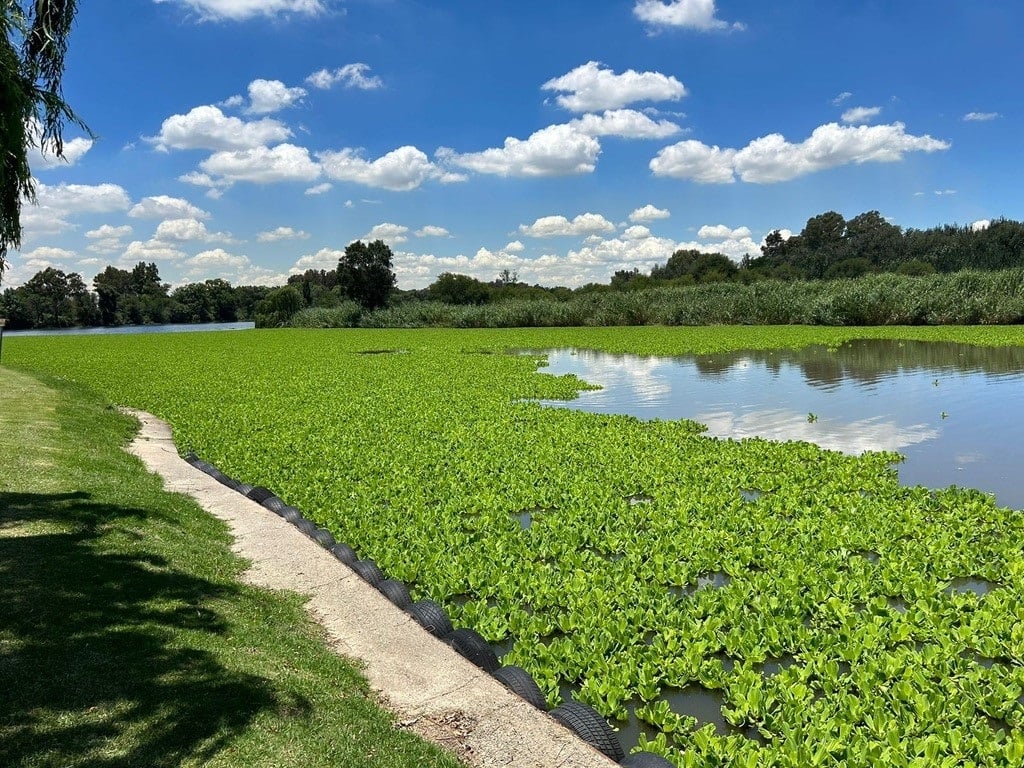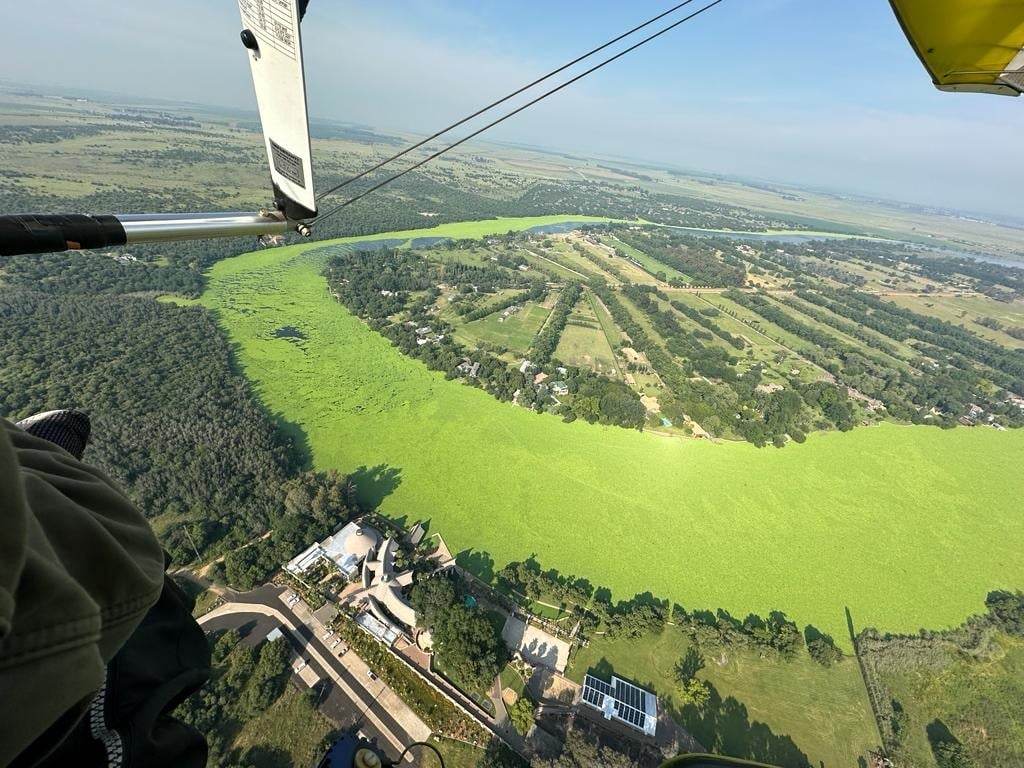
Vigorous attempts are under way to remove the offending water lettuce from the Vaal River, typically driven by public anger, sometimes manifesting as industrial-scale action. But this will result in a win-lose dynamic, writes Anthony Turton.
The very definition of insanity is doing the same thing repeatedly while expecting a different outcome. This simple statement encapsulates the essential element of success for any government, which is the ability to self-correct through policy reform.
When the Covid-19 pandemic hit, the initial response was to isolate the virus by preventing its spread through uncontrolled movement of people. That approach significantly impacted the economy, but it also angered the public, destroying trust in government. The logical evolutionary response was to adapt to the presence of the virus when it became clear that attempts to isolate it were futile.
The strategic question becomes isolation versus adaptation.
The same is true in the Vaal River water lettuce saga. Vigorous attempts are underway to remove the offending plants, typically driven by public anger, sometimes manifesting as industrial-scale action.
Free-rider principle
I have seen videos of three large excavators removing water lettuce from the river and loading it onto a fleet of large earth-moving machinery, presumably for disposal elsewhere. This is a sophisticated endeavour on an industrial scale, with careful thought to the efficiency of the process. I am reliably informed that this is privately funded and has cost a staggering R4 million.
I have also been informed that the main source of cash is from the riparian owners, but rifts are appearing because some refuse to pay. The old free-rider principle rears its head as it does in all common property goods. This happens when consumers of common property goods benefit without paying. Ultimately this natural phenomenon drives a rift between those who are paying, versus those who are free-riding.
We can, therefore, ask ourselves if it is prudent to stop and reflect for a moment as we consider a new strategy.
Let us first apply our minds to gain some clarity in our thinking. If we think in terms of a game being played, we can isolate the following groups as opposing teams on the field of play.
The one team is government, but they are not monolithic. There are two main departments – Department of Water and Sanitation (DWS) and Department of Forestry, Fisheries and the Environment (DFFE) – each with different legal mandates, but both are functionally responsible for managing the Vaal River.
These two government departments are legally accountable, but they have abdicated their responsibilities to Rand Water because of their own institutional failures. This is an SOE acting on behalf of DWS but lacking the budget and the personnel to deal with the issue. How can Rand Water prevent sewage flows from the two Gauteng metros, Johannesburg and Ekurhuleni?
READ | Anthony Turton: What took 50 years to occur in Hartbeespoort Dam, took only 3 years in the Vaal
Therefore, we must see Rand Water as a proxy player, pushed onto the field to fill the vacuum left by a failing state, because Cooperative Governance and Traditional Affairs (Cogta) and every municipality they represent are invisible players too.
The other team consists of society, but they, too, are not monolithic. From the outside looking in, we have almost 20 million people directly dependent on the Vaal for their livelihoods.
Most of these people are blissfully ignorant of what is happening, so they are not real players on the field. The most vocal players are typically the riparian landowners, all of which are directly impacted by having their access to the water blocked by the presence of massive rafts of lettuce.
They are typically more vocal than the public and, dare I say, are probably in a different income bracket than the average citizen. These are the main players on the field, typically fielding the highest energy strikers, but not all are willing to pay their share for the benefit of having thousands of tons of water lettuce removed.
Now that we know the main players let us look at the tactics on the field of play. The citizen’s team is dominated by the riparian owners, so their main interest is to clear the floating rafts of biomass. They are frustrated by what they perceive to be the slow pace of government, which is the opposing team. These two teams face off, with the strikers on the government team being their proxy player, the environmental managers at Rand Water. Their strategy is to knock the floating weeds back with chemicals and then to release insects to destroy what is left.
Chemical not registered
The problem they have is that the chemical of choice is not registered for use against water lettuce in aquatic ecosystems, so they must commit a foul, hoping to avoid the referee's whistle. That foul is to justify the use of the chemical as an emergency measure and then to soften the blow by saying it’s a sub-lethal dose. The citizen's team is deeply divided because they represent such diverse interests.
The riparian owners want to also use the herbicide because they perceive this approach to be most effective in meeting their direct short-term needs, so they encourage the government team to make that specific play, but this is not in the direct interest of almost 20 million people who are not riparian owners. A significant portion of that cohort is concerned about long-term human health implications associated with the use of herbicide, so they are logically opposed to this tactic, but they are under-represented on the team, so their voice is muted.
READ | Anthony Turton: Pecanwood Estate experiment leads to discovery of new species of microfauna
From this, we can see that the dynamics of the game are really centred on the perceived need to have a short-term visible impact. In technical terms, this is a zero-sum game, where the gain of one side directly equates to the loss of another.
This win-lose model gives the game a unique set of dynamics because the focus of any measurable impact is on the immediate eradication of weeds, without regard to the long-term implication of a sub-lethal dose on building chemical resistance within the target weed species. Sub-lethal doses only kill the weak plants, leaving the strong to multiply. Peer-reviewed science in the USA reports that this very thing is happening in certain weed species in a relatively short space of time.
Now that we understand the game, we can ask a different question. What is the best strategy to create a plus-sum dynamic? This creates a win-win outcome, so it is less conflictual in nature. Here, we might think of experimenting with the use of a water credit. Imagine that all activities, such as mechanically removing biomass, create a measurable positive impact for society.
We know that elevated nutrients from sewage sustain elevated growth of biomass, so the removal of biomass directly equates to the removal of nutrients. This is measurable, so a fungible credit with a known cash value can be issued and traded. The beneficiary would be the government, so they inject the liquidity into the market.
The machine operators are performing a quantifiable public service, so they are paid via the credits. Other known polluters, such as mining operations and petrochemical companies, also inject liquidity by buying the credits, creating an offset for their own pollution activities.
This new approach is entirely doable, so maybe we must open a public debate on how to support both teams, not only vocally but also with the funding needed to convert the game from a win-lose dynamic to a win-win instead.
- Dr Anthony Turton is with the Centre for Environmental Management University of Free State.
Disclaimer: News24 encourages freedom of speech and the expression of diverse views. The views of columnists published on News24 are therefore their own and do not necessarily represent the views of News24.




 Publications
Publications
 Partners
Partners

























